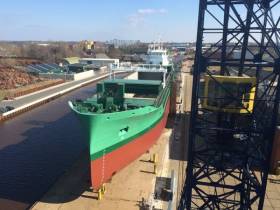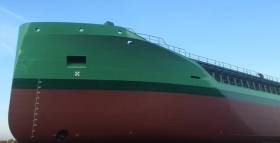Displaying items by tag: Arklow Valiant
#ItsALLnew – It will be a first for Arklow Shipping now in their 50th year as a new general cargoship launched tomorrow is to be bestowed with the name Arklow Valiant, writes Jehan Ashmore.
Also setting a new departure for the 'Valiant' is a considerably different bow design when compared to a previous pair of completed sisters, Arklow View and leadship Arklow Vale. The latter single-hold cargsoship which is designed with energy-saving bow characteristics is currently docked in Dublin Port today.
Arklow Valiant represents the third of the Royal Bodewes Eco-Trader 5,100dwt series built to the Dutch shipyard’s own design. The newbuilding no.723 is to be launched tomorrow morning at Hoogezand on th outskirts of Groningen.
To compare the new design of the bow, click previous footage here of Arklow Vale and that of a photo of newbuild on her first call to Dublin Port in January.
The cargoship is one of a 10 ship order by Arklow Shipping. They will serve Dutch division, Arklow Shipping Nederland B.V. based in Rotterdam and among the bulk dry cargoes they will transport this will include grain, animal feed and steel rails.
A previous generation of ‘V’ class vessels but built to a different design were disposed last year by ASL. The ageing trio were named Arklow's Viking, Venture and Vale.
Another Arklow ‘Eco-Trader’ But Bow Design Differs to Sisters
#DifferentBow - The bow foreship of Royal Bodewes newbuild (yard No.723) to be named Arklow Valiant, was last week transported from the contruction hall to the outfitting quay at the Dutch shipyard, writes Jehan Ashmore.
The foreship was joined to the newbuild’s stern section complete with superstructure. What is notably different is the bow design compared to her sisters built to the yard’s ‘Eco-Trader’ 5,100dwt design series.
Leadship, Arklow Vale (yard No. 721) see first call to Dublin Port (and photo), features an energy effecient bow designed to save on fuel costs. Note the straight stem to reduce wave contact and upper sloping hull plating that faces astern (back towards the bridge).
To also compare the differences, watch the above video (below) of the newbuilld with a slightly raked bow yet remains more conventional when contrasted to launch footage of Arklow Vale last September.
The latest completed sister Arklow View (yard No. 722) carried out sea trials last month.
At almost 87m in hull length overall, the single-hold cargoships are to serve Arklow Shipping through Dutch division Arklow Shipping Nederland B.V. The pair are registered at Rotterdam.
A service speed of around 12.5 knots is generated by a main engine (MaK 6M25 1740 kW) with a Siemens Gearbox. As for the controllable pitch propellers they are manufactured by Berg.






























































